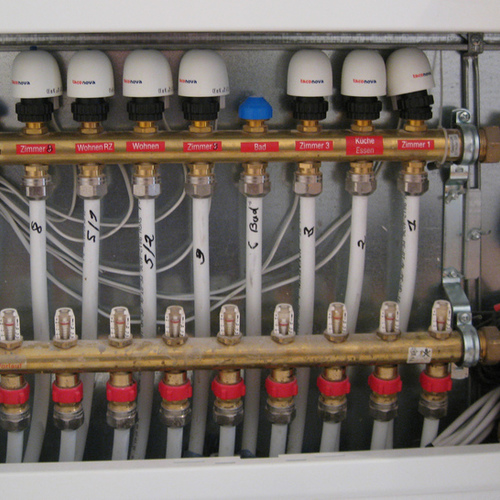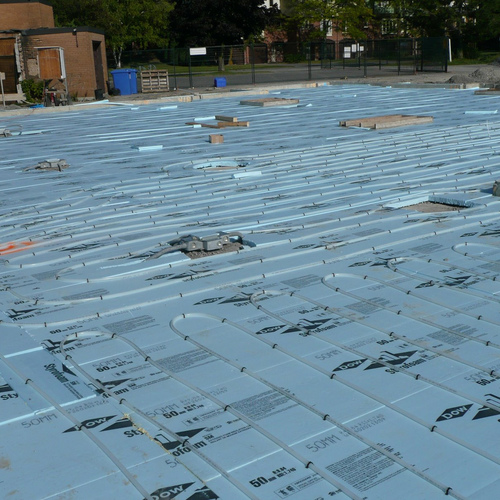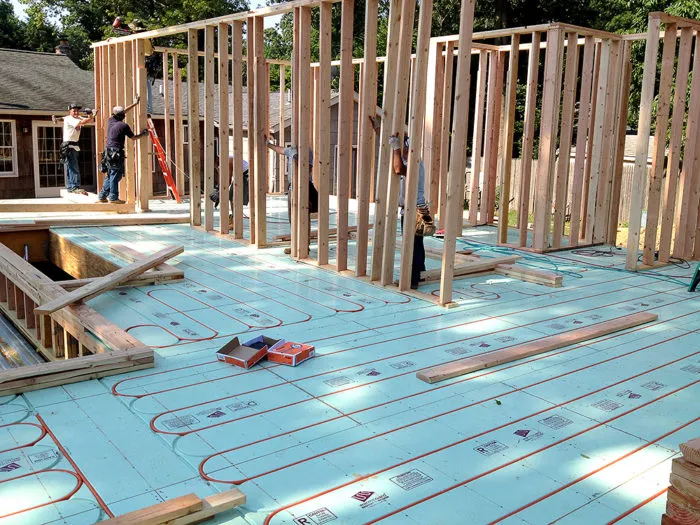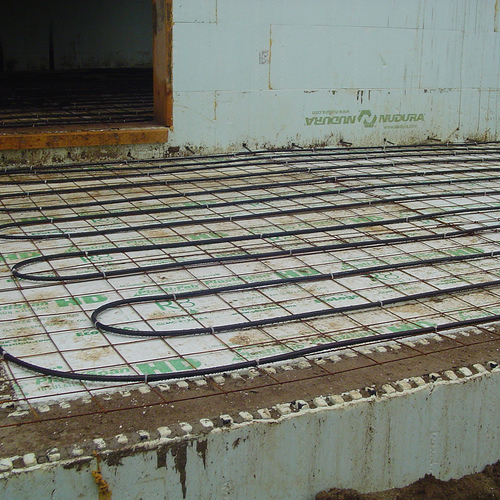
Michael Schonlau is building a house in Omaha, Nebraska, where he can expect 6,000+ heating degree days a year. He’s planning on putting a radiant-floor system in the basement slab of the ranch-style home with a footprint of about 1,600 sq. ft.
In a recent posting on GBA’s page, Schonlau asked whether he’ll have to install radiant loops under the subfloor of the first floor as well as the basement — or will the heat generated in the basement migrate upstairs and keep the house comfortable?
“Please assume the house will be well-insulated and air sealed, with ‘good’ windows,” he wrote. But will that be enough to keep his wife’s toes warm through a long Nebraska winter?
It’s been done
GBA senior editor Martin Holladay tells Schonlau it can be done, but “but only if you aim for near-Passivhaus levels of airtightness, insulation, and window quality.”
Dan Kolbert is more optimistic.
“We’ve built a couple of houses on slabs with no heat distribution on the 2nd floor,” Kolbert says. “They were good, but certainly not Passive House.”
One of the houses had double-glazed windows, “not huge R-value,” very good solar orientation and a sprawling layout. Radiant-floor tubing was extended to the second floor, but after two winters the client had no interest in second-floor heat distribution.
The other house was much tighter. Here again, heat in only the first-floor slab was enough to keep the house toasty.
“I essentially agree with Martin, though, only disagreeing in what the threshold might be,” says Kolbert. “An energy model (and someone who knows what to do with it) would help make the decision.”
Robert Riversong, however, isn’t so sure it’s going to work.
“Unless your house is very energy efficient (32,000-45,000 btu/hour maximum design load), then a…
Weekly Newsletter
Get building science and energy efficiency advice, plus special offers, in your inbox.

This article is only available to GBA Prime Members
Sign up for a free trial and get instant access to this article as well as GBA’s complete library of premium articles and construction details.
Start Free TrialAlready a member? Log in















21 Comments
Being in Omaha what is
Being in Omaha what is Michael going to do for AC, not to many people go without ac. Even if the original owner can do without ac what will happen for resale. Much cheeper and easier to install zoned heating/cooling then to add it later.
I also wonder about the interconnectedness of the basement to the main floor. How do you get the heat it in to the bedrooms when a door is closed.
Omaha does get days of near and below zero and the summers can be hot and humid. Summer hiigh in the 90's to low 100's .
I think there are two many if's in getting heat circulated to all parts of the main floor. If the home will have ac and HVAC ducts then there could be an option for supplemental heat (when needed) and a method of air circulation from downstairs and to upstairs.
As an Omaha resident I am aware of the climate considerations plus years of appraising homes I have not been in a home built in the last 20 years that did not have ac.
I would be interested in seeing the house. Sounds like it will be cutting edge for Omaha.
Calling all HVAC engineers
Unfortunately the GBA forum as far as I have noticed has not engaged any savy HVAC engineers or contractors.
You're in demand and could make yourselves known to us. I'd be interested especially in anyone in Minnesota.
So why not put the radiant
So why not put the radiant loops under the first floor? Radiant ceiling to heat the basement, and Radiant floor for the the first floor? Seems like it would be easier to get even transfer that way than to rely on convection between levels.
Calling all HVAC engineers & contractors
We're a contractor serving the Omaha surronding area since 1929 and for years have instaled many hydronic in-floor radiant heating systems in homes raging in size from 1,500 to 18,000 sq/ft as well as ice melt systems for driveways and sidewalks. Generally, we install the in-floor radiant heat on the lower level only with conventinial heating and cooling systems serving the upper floors. We have installed these systems on the main and upper levels but the feed back we hear from our clients is they find that with the open stairways of todays designs they don't use the in-floor on the upper levels due to the "heat rise" effect. They go on to tell us that the in-floor radient heat works so well on the lower level that they tend to leave it on during the air conditioning months at a lower setting to help keep the lower level from from over cooling and in turn experience a much more even temperatures throughout the home.
We have in-floor heat both in our office and shop area and is our main heat source. My first hand experience in the office is we tend to leave it at much lower setting than with conventional heating systems, otherwise it tends to feel much too warm. In the shop what we find is we can leave the garage doors open for a time and within minutes of closing them the space is back at the desired temperatue setting.
AC and Heat simultaneously in a single family house?????
If the floor heat is used during cooling months for comfort, there is something seriously wrong with the system design and this is not something to brag about.
In this scenario, both systems might be running, "fighting" each other, wasting $$, even if it's 72F outside.
Just like Richard Nixon in the White House
President Nixon was said to enjoy a fire in his fireplace, year round. During the summer, he instructed his aides to put the air conditioner on "high" so he could be comfortable in front of his fire.
Kevin, we're talking about
Kevin, we're talking about larger homes with big open stairways having zone control systems for all three levels. So it certainly is not designed to call for heating and cooling of any one level at the same time. With the AC calling on the upper levels and cold air naturally falling to the lower levels the client likes the idea of being able to temper the lower level to be the same temperature as the upper levels. I'm certainly not going to tell the client not to do something that makes him comfortable!
Radiant Basement with forced-air upper levels
Like Rick in Omaha, we installed boiler based radiant in our lower level and geothermal forced-air in our 1st and 2nd floors. The theory was, dry basement plus geothermal efficiency. Unlike Rick's clients, however, we don't run the radiant in the basement unless a guest is staying in the craft room. Our home was built in 2008 and is Energy Star certified, so it's well insulated and pretty tight. The basement stays 65 deg. year 'round, but the boiler never receives a call for heat there is no A/C down there. To be fair, there is no "warm toes" sensation on the stained concrete floor... only when you're bellied up to the bar!
For our next build, we're thinking of putting radiant and high velocity A/C on the 1st and 2nd levels, and no heat in the basement. The basement will be used for exercise, kids play and storage, so 65 is just fine. I'm trying to design a simple way for the waste heat from the mechanicals to be distributed as a bonus, to be turned off in the summer when the basement is an ice cold refuge.
I hadn't even considered skipping the the hydronic on the 2nd floor until I read this article, and it doesn't sound conclusive enough to risk it. It seems to me, you'd have to over-heat the lower level in order to get the upper level warm enough. Wouldn't you rather have 2 zones so your upper level could be set lower if necessary?
Thinking in another way, to keep your entire (presumably tight & superinsulated) house 72 deg. will take roughly the same BTUs whether you heat from one floor, both, or all 3 so we're really talking about the length of pex rather than energy efficiency. Getting a 3rd party Engineer to do all your calcs could cost more than adding hydronic to the upper level!
Think "virtual wood stove"
Rather than running the entire floor in radiant, another approach that has worked for us is to install radiant in a small area of the house. In the Berry residence http://www.chandlerdesignbuild.com/indexFull.php?id=berryResidence&t=The%20Berry%20Residence we installed an extremely limited area of solar-assisted radiant slab under tile in the kitchen, entry hall, mudroom, laundry and master bedroom with oak every where else including a second floor craft room w/ two guest bedrooms, all oak floor.
In many ways it performs as a "virtual wood stove" creating a luxurious experience entering the house to an enveloping warmth and hanging out in the kitchen for meals but also warming the rest of the house most of the fall and spring. During the colder months they have an RSF Opel wood stove to supplement in the living room and a heat pump which they use very little saying that the bedrooms are somewhat cooler but with the doors open they are quite comfortable most of the year. I assume that they prefer a cooler bedroom which is likely less of an issue with the warm floors in the master bath and that they probably don't use the upstairs bedrooms in the winter except when they are running the wood stove when they have family visiting for holidays.
Another client reports that on cold nights they warm up the master bedroom by leaving the bathroom door open and allowing the warmth from the radiant heat in there to flow out into the bedroom, which has an oak floor.
We've taken this another step in our most recent "affordable green" prototypes where we have primary and secondary zoning, essentially the heat exchanger adds heat to two zones out of four and the water in the floor runs through those zones and then through the other two before returning to the heat exchanger, the secondary zones never "feel warm" but they don't get cold either. This allows us to designate a few areas for toasty toes and use the other areas for thermal fly wheel.
I discuss this in more detail here: http://www.chandlerdesignbuild.com/indexFull.php?id=affordableGreen&t=Affordable%20Green and will be updating this page as we get results back from the 2,400 sf home we just finished with this system and the one 1,040 sf gut remodel version we should be wrapping up in time for Christmas.
Tiny boxes to type in!
I meant to say that we installed the radiant in the master bath in the Berry residence, the master bedroom is oak. That's a staple up in the master bath there and doesn't generate enough heat transfer to heat the bedroom.
We've since moved to using 3/8" PEX in those little bathroom zones, tying it into the recirculating hot water system, stapled to the top of the sub-floor with tile backer laid between the tubes and tile installed directly touching the 3/8 tubing with 120 degree water flowing in it. Big heat transfer improvement there! Very fast response, walk in, bump up the t-stat, and hop out of the shower to a toasty warm bathroom. And no issues with scalded toes by the way, I guess the T-stat gets satisfied long before the floor is dangerously hot. You can definitely tell where the pipes are though.
This is the only place where we use potable radiant. In general we use flat plate heat exchangers to isolate radiant floor loops from the potable drinking water but when the entire floor loop has on the order of a gallon or two of water in it I'll make an exception.
Details
Is the main level open to the lower level? If not, heat will have to pass through the floor system and a ceiling in the basement if this is finished. It becomes a delta T equation and the basement will have to be somewhat warmer than the upper level to offset the upper level heat loss. Stack effect will help some but the goal should be a super efficient building envelope with little thermal buoyancy. If built to PH standards it may work, otherwise buy the wife some warm slippers.
Well worth it...
I have a two-story with a central cathedral-ceiling foyer, geothermal heat pump, and staple-up radiant flooring throughout. I considered heating it all with one floor, but wanted the control of heating each bedroom appropriately. I admit I may have gone a bit overboard, the house with apartment now has 10 zones. I put r-11 fiberglass insulation between floors with aluminum foil on top, to drive the second floor heat up, and assist with sound transmission. On the first floor, it's Reflectix and r-30 in the crawl space. All tubing is stapled up to the subfloor. I skipped the very expensive aluminum diffuser plates, and am fully satisfied that I did. Southeast Alaskan winters are similar, 9000 HDD and -4 design temperature. I walked into an HVAC contractor, and he obviously used the front door method of heat load calculation. "There's no house that will be comfortable around here with less than 23 Btu/ft" AKA "This unit is 35 7/8" wide.. PERFECT"...
I had an engineer do an ASHRAE calc, he came up with 5 Btu/ft, with a 20% cushion. This with a "just" code-compliant design. So far, 3 years and the backup heat hasn't been used once.
All that said, to address the question, I would do it all over again; the ability to shut down a room, or make grandma comfy when she visits from Hawaii is WELL WORTH IT.
Radiant/Passive Solar
Our builder had built his own home, here in Northern Utah, a few years ago with radiant heat on the main floor, and had not provided any heat source for the basement. His home had good solar orientation, but was not built to be passive solar. It was built to Energy Star standards. Surprisingly, for reasons neither of us understand, his basement stays warmer than his main floor during the heating months!
Last year we built a passive solar (also Energy Star) home in Northern Utah. After great debate, we installed radiant on the main floor only. In the basement, we installed a gas furnace, as our children's bedrooms were there and we were nervous the radiant/solar from the main floor would keep the basement comfortable.
I think the basement furnace was a waste. Thus far, (only one winter) the thermostat in the basement never got cool enough to activate the furnace. Our basement isn't warmer than the main floor (it doesn't get the passive solar heat that the main floor gets) but it's very comfortable.
Radiant Heat in the Basement
Our climate is fairly extreme with Winters usually reaching -15 F or less and Summers occasionally getting to 90 F but usually that only happens 2 or three days a year.
I built a hybrid heating system that is hot water baseboard utilizing a 25mm thick extruded aluminum baseboard that actually looks like a wooden baseboard. This is our main heat. I also installed radiant heat in the floors- Manufactured wood over fibermesh concrete. The thermostat for the floor heat is set at 68 degrees F and is located four feet above the floor. The "conventional heat" thermostat is set at 70 (and is located five feet six inches above the floor. Since our walls are over 60% glass we also gather a lot of passive solar heat. The way it usually works is that the floor thermostat kicks in first around 6:30 am raising the floor temp to no more than 80 degrees F- Nice cozy floor without uncomfortable hot feet. The other thermostat kicks in around 7:00 am to bring the overall temp up to our desired 70 degrees. The floor heating will most likely have shut down by this time unless we are at or below 15 degrees outside. In that case the floor heating will continue to heat assisting the baseboard heat.
We also have radiant in our basement floor but use it seldom as we do get some down radiant from the living level and don't use the basement level often.
We find the hybrid system the best of all worlds providing comfortably warm floors and room temperatures where we want them. Drafts are non-existent, not like with forced hot air heating/cooling. We use central air but actually have two systems with high efficiency output that doesn't give up cooling efficiency to a system primarily designed for heating. The ducts in a combo system are generally designed for either cooling or heating- Not both.
We don't experience a lot of floor override except when we have a cool morning at 6:00 am followed by a blazing warm day.
I really can't imagine relying on a radiantly heated basement floor to provide heat to upper floors. For one thing no matter how well a basement floor is insulated a percentage of heat energy will go down into the ground and be lost- That could become very expensive! Such a system might be OK in a more temperate climate like Missouri or Georgia maybe.
Radiant/Passive Solar
Follow up to earlier post:
While we were building we had the furnace on in the basement while the mudders were working. This was before the boiler was installed for the radiant upstairs. The furnace only blows in the basement, but we thought we'd get some good heat transfer upstairs through the stairwell, and a light well in the center of the house, just through convection. It didn't work at all. We had the furnace turned up to 78 degrees in the basement and the only heat we seemed to be getting upstairs was from the passive solar.
Radiant in Basement - Forced Air Main & 2nd Floor
I am planning to build a house in the mountains of western MD where AC is needed about 1 month out of the year & 0 deg is not uncommon in the winter. I am thinking of installing a dual geothermal system with Radiant heat in the basement slab and geothermal forced air for the main and 2nd floors. I plan to also add some vents from the floor one system into the basement which can manually be opened or closed as needed to provide AC to the basement or quicker heat for those days with a large temperature drop.
Has anyone had any experience with using this type of system? Is this a good way to go?
I know of one house that was built on a slab that had geothermal radiant heat in the slab for the 1st floor and Geothermal forced air in the 2nd floor with a few vents through the ceiling to the 1st floor for summer AC. It works quite well. The temperature does not fluctuate as wildly in this house as it does in some radiant only houses in the same area.
Response to Ken M
Ken M,
My advice to you is the same I give anyone contemplating the installation of a ground-source heat pump: are you sure it's the best use of the $15,000 to $25,000 that the system is likely to cost?
In most U.S. locations, the money is better spent improving your thermal envelope: installing more insulation, reducing air leakage, and buying better windows. If you follow this route, you'll only need a small heating and cooling system, which should cost much less than a ground-source heat pump.
Martin - Ground source heat pump vs Improved Envelope
Martin - In regards to cost effectiveness and best use of money... Do you have any guidelines as to where one gets the best return on the dollar spent? For example, as you add more insulation you get less return per dollar spent - Ground source heat pumps are expensive to install but cheap to use - Electric baseboard is cheap to install but expensive to use.
Over a 15 to 20 year time period, where is the "sweet spot" where one can get the biggest bang for the buck? Is it the Passivhaus standard or something less than that? I am certain that it is not the current average production builder standard...
Second response to Ken M
Ken M,
Do you have a designer or architect? Any designer or architect should be capable of performing heat-loss calculations and energy use estimates -- if they can't, it may be time to find a different designer. If necessary, consult with a HERS rater, who will be completely familiar with answering the questions your raise.
Many new superinsulated buildings can be heated with a couple of gas-fired space heaters or a ductless minisplit unit with two or three indoor units. You can buy an awful lot of insulation for the price of a ground-source heat pump.
Heat pump vs. insulation..
I agree with Ken M... There is a point where superinsulation and high technology windows are too expensive to bring reasonable returns. Chasing that last .01u can cost big bucks. In my situation, the heat pump, for 5000 square feet, cost $5200, the earth loops 1200, excavator rental 1500, and my labor, I suppose 80 hours excavating, fusing pipe, etc. An oil boiler, or even electric boiler, was about 10% less. As a kicker, Alaska gives $7500 to any new construction with 5 star plus rating,(earned purely by having a GSHP) and the feds kicked in a 30% tax credit. For that, I am spending about $1200 per year on heat, where my brother, with much more insulation, same size house, and oil boiler, spends over $4000, plus averages $3-400 per year maintenance. I'm thinking geothermal was the correct decision.
thank you greg anderson (why so harsh on GSHP?)
i find it somewhat deplorable that the GSA advisors are regularly discouraging GSHP installs.
it is the most straightforward way i have found to get away from the use of fossil fuels which to me is a very important aspect of building green.
until greg anderson's comment above i've seen no other mention on this site of the many federal incentives and the long term savings of using such a system, added to the fact that on a new build, you can share the same well with domestic water, which furthers the savings.
Log in or become a member to post a comment.
Sign up Log in